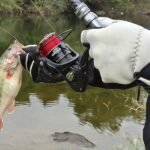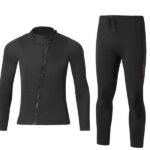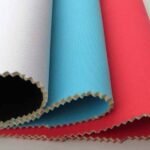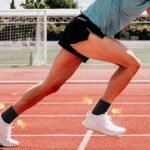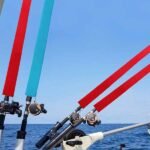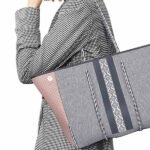When you’re standing in your workshop, finger on the trigger for your next big product launch—maybe a sleek neoprene laptop sleeve or a heavy-duty canvas duffel—the very first question is the toughest: which fabric? You need something that checks the boxes on durability, feel, cost, and sustainability.
Neoprene offers unmatched stretch, insulation, and water resistance, making it ideal for bags, koozies, wetsuits, and more. In contrast, polyester excels at UV stability and low cost, nylon at abrasion resistance and strength, and canvas at structure and eco-friendliness. Your choice hinges on end-use demands: flexibility and waterproofing (neoprene), rigidity and breathability (canvas), or a balance of both (polyester/nylon blends).
Imagine launching a custom neoprene phone pouch that doubles as a hand warmer—only to have it sag and leak after a few uses. Or designing a high-end canvas tote that looks premium but feels too stiff to the touch. Stick around as we unpack neoprene’s superstar qualities, pit it against polyester, nylon, and canvas, explore specialty blends, break down cost and sustainability considerations, and give you a clear, step-by-step fabric selection roadmap. By the end, you’ll know exactly why Szoneier’s neoprene solutions could be your next best seller.
What Is Neoprene and What Are Its Key Properties?

Neoprene is a synthetic rubber (polychloroprene) prized for its elasticity, thermal insulation (R-value ≈ 0.15 m²·K/W), water resistance, and durability. It stretches up to 500%, cushions impacts, and resists UV, oils, and chemicals—properties that set it apart from typical textiles.
Let’s dive deeper into why neoprene has been a game-changer since the 1930s:
- Molecular Structure & Closed-Cell Foam Neoprene’s backbone of chloroprene monomers forms tiny, gas-filled cells in the cured foam. Those cells trap heat and provide bounce.
- Cell Size: 0.1–0.3 mm diameter
- Cell Density: 15–30 cells per mm²
- Thermal R-Value: 0.13–0.17 m²·K/W (higher than most fabrics)
- Stretch & Memory Try stretching a neoprene sample 3× its length—it snaps right back. Typical formulations allow:
- Elongation at Break: 200–500%
- Modulus at 100% strain: 0.2–0.6 MPa
- Recovery Rate: >95% after 100 cycles
- Thermal Insulation & Comfort With a thermal conductivity around 0.17 W/m·K, neoprene outperforms cotton (0.41), nylon (0.25), and polyester (0.21), keeping contents—and hands—warm.
- Cold-Water Wetsuit Ratings: 2 mm neoprene suitable for 20–25 °C water; 5 mm for 10–15 °C.
- Chemical & UV Resistance Neoprene resists oils, acids, ozone, and UV. In accelerated UV tests (500 hrs), tensile strength drops <10%, whereas nylon can lose 20–30%.
Table 1: Key Neoprene Characteristics
| Property | Value |
|---|---|
| Density | 250–800 g/m² |
| Thickness Range | 0.5–12 mm |
| Tensile Strength | 5–10 MPa |
| Tear Strength | 20–50 N/mm |
| Thermal Conductivity | 0.13–0.17 W/m·K |
| Water Absorption | <2% by weight |
| UV Degradation after 500h | <10% strength loss |
Which Common Fabrics Are Compared Against Neoprene?
The main contenders are polyester (lightweight, cost-effective, UV stable), nylon (strong, abrasion-resistant, modest stretch), canvas (structured, breathable, eco-friendly), and neoprene blends (e.g., neoprene-cotton or neoprene-linen for unique performance hybrids).
Choosing between these boils down to your priorities:
- Polyester
- Strengths: UV stability (colorfast after 2,000 hrs), moisture-wicking, low cost ($1–2/kg).
- Weaknesses: Low insulation, limited stretch, moderate breathability.
- Nylon
- Strengths: High tensile (6–9 MPa), tear strength (30–70 N/mm), abrasion resistance (20k–40k Martindale cycles).
- Weaknesses: Can absorb 3–5% water, potential yellowing under prolonged UV.
- Canvas (Cotton)
- Strengths: Breathable, eco-friendly, structure for rigid bags, biodegradable.
- Weaknesses: High water absorption (8–15%), heavy (300–600 g/m²), prone to mildew.
- Neoprene Blends
- Neoprene-Cotton 60/40: Softer hand, better breathability; R-value ~0.20.
- Neoprene-Linen 70/30: Premium texture; R-value ~0.18.
- Neoprene-Spandex 80/20: Up to 600% stretch; ideal for form-fitting gear.
Table 2: Fabric Feature Comparison
| Fabric Type | Cost Index* | Stretch | Insulation | Water Resistance | Use Cases |
|---|---|---|---|---|---|
| Neoprene | 3.5 | High | High | Excellent | Wetsuits, sleeves, koozies |
| Polyester | 1.0 | Low | Low-Med | Good | Apparel, linings |
| Nylon | 1.2 | Med | Med | Fair | Backpacks, gear |
| Canvas | 1.3 | Low | Low | Poor | Totes, duffels |
| Neoprene Blends | 2.5 | Med | Med-High | Good | Hybrid apparel, bags |
- Relative cost, polyester = 1.0
How Does Neoprene Compare to Polyester in Performance?
Neoprene outshines polyester in stretch (200–500% vs 5–15%), insulation (0.17 vs 0.21 W/m·K), and cushioning, but polyester wins on weight (100–150 g/m² vs 250–800 g/m²) and UV stability—making polyester ideal for cost-sensitive, outdoor apparel.
Elasticity & Comfort
- Neoprene: Think of a snug-fitting wetsuit—huge stretch, tight recovery. Perfect for can koozies that grip, phone sleeves that hug.
- Polyester: Limited give (5–15%), good for fixed-shape linings or simple pouches where stretch would distort.
Thermal & Moisture Behavior
- Neoprene: Keeps heat in, water out—great for cold-weather accessories.
- Polyester: Dries fast, wicks sweat—go-to for activewear exteriors.
Durability & Care
- Neoprene: Holds up to oils and mild acids; avoid chlorine bleach or prolonged sun.
- Polyester: Machine washable, UV-resistant; can pill if rubbed harshly.
Weight & Cost
- Neoprene: 250–800 g/m², $5–8/kg.
- Polyester: 100–150 g/m², $1–2/kg.
Table 3: Neoprene vs Polyester Quick Metrics
| Metric | Neoprene | Polyester |
|---|---|---|
| Stretch (%) | 200–500 | 5–15 |
| Thermal Conductivity | 0.17 W/m·K | 0.21 W/m·K |
| Water Uptake | <2% | <1% |
| UV Stability (500h) | 90% retention | 95% retention |
| Weight (g/m²) | 250–800 | 100–150 |
| Cost ($/kg) | 5–8 | 1–2 |
How Does Neoprene Stack Up Against Nylon and Canvas?

Neoprene offers better insulation and stretch than nylon (15–30%) and canvas (<5%), while nylon beats neoprene in tensile strength (6–9 vs 5–10 MPa) and canvas leads in breathability and eco-credentials.
Strength & Abrasion
- Neoprene: Tensile 5–10 MPa; tear 20–50 N/mm; Martindale 10k–20k cycles.
- Nylon: Tensile 6–9 MPa; tear 30–70 N/mm; Martindale 20k–40k cycles.
- Canvas: Tensile 2–4 MPa; tear 15–40 N/mm; Martindale 5k–10k cycles.
Structure & Feel
- Neoprene: Soft, cushioned—great for protective gear.
- Nylon: Sleek, technical—holds shape for backpacks.
- Canvas: Textured, natural—ideal for rugged totes.
Environmental Considerations
- Neoprene: Synthetic, limited recycling; upcycled scrap emerging.
- Nylon: Recyclable via chemical or mechanical means.
- Canvas: Biodegradable; organic cotton reduces pesticide impact.
Weight & Packability
| Fabric | Weight (g/m²) | Packability | Eco Impact |
|---|---|---|---|
| Neoprene | 250–800 | Low | Medium |
| Nylon | 75–150 | High | Medium-High |
| Canvas | 300–600 | Medium | High |
Is Neoprene or a Neoprene Blend Better for Specialty Applications?
Neoprene-cotton blends soften neoprene’s feel and improve breathability, while neoprene-linen blends create upscale textures. For wetsuits, pure neoprene (2–5 mm) remains best; for apparel and accessories, blends (neoprene 60–80% + natural fiber 20–40%) strike a balance between insulation and comfort.
Neoprene-Cotton 60/40
- Hand Feel: Softer, less “sticky” foam surface.
- Breathability: Improved by ~20% over pure neoprene.
- Use Cases: Jackets, sleeves, wraps.
Neoprene-Linen 70/30
- Texture: Premium, slubbed appearance.
- Weight: 350–500 g/m².
- Use Cases: Fashion accessories, high-end laptop sleeves.
Neoprene-Spandex 80/20
- Stretch: Up to 600%, ideal for compression wear.
- Recovery: >98%.
- Use Cases: Sportswear, gloves, ergonomic sleeves.
Wetsuit Grades
- Yamamoto #39: Ultra-stretch (500%), soft touch—$20–25/m².
- Smoothskin vs Microcell: Smoothskin repels wind, microcell increases thermal retention.
Table 5: Neoprene Blend Performance
| Blend | Stretch (%) | Weight (g/m²) | R-Value (m²·K/W) | Ideal For |
|---|---|---|---|---|
| Neoprene-Cotton 60/40 | 150–300 | 300–450 | 0.20 | Casual apparel, wraps |
| Neoprene-Linen 70/30 | 180–350 | 350–500 | 0.18 | Premium sleeves, accessories |
| Neoprene-Spandex 80/20 | 400–600 | 250–400 | 0.17 | Compression gear, sportswear |
| Standard Wetsuit | 200–500 | 500–800 | 0.17 | Dive suits |
What Are the Cost, Sustainability, and Manufacturing Implications?

Neoprene costs $5–8/kg, involves energy-heavy production (300–400 MJ/kg), and limited recycling—but Szoneier’s closed-loop R&D can integrate recycled feedstocks. Polyester and nylon cost $1–2/kg, are widely recycled, and require simpler dyeing; canvas (cotton) is $2–3/kg, biodegradable but water-intensive in finishing.
Raw Material Pricing & Energy
| Fabric | Cost ($/kg) | Energy (MJ/kg) | Water (L/kg) |
|---|---|---|---|
| Neoprene | 5–8 | 300–400 | 50 |
| Polyester | 1–2 | 200 | 30 |
| Nylon | 1–2 | 200 | 30 |
| Canvas | 2–3 | 150 | 10,000 |
- Neoprene: High cost justified by performance.
- Canvas: Major water footprint in cotton cultivation.
Recycling & End-of-Life
- Neoprene: Emerging chemical recycling; scrap up-cycling at Szoneier.
- Polyester/Nylon: Mechanical & chemical recycling streams growing.
- Canvas: Compostable; ideal for eco-brands.
MOQ & Lead Times
| Fabric | MOQ | Lead Time |
|---|---|---|
| Neoprene | 500 m | 15–20 days |
| Polyester | 1,000 m | 10–15 days |
| Nylon | 1,000 m | 10–15 days |
| Canvas | 800 m | 12–18 days |
Szoneier’s low MOQ, fast sampling, and integrated lamination (foil, fabric backing, custom printing) give you unmatched flexibility to test market reactions quickly.
How Do You Select the Right Fabric for Your Product Line?

Start by defining end-use (insulation vs breathability), weight budget, branding (premium texture vs rugged look), and sustainability goals. Use a decision matrix to score fabrics—neoprene for insulation/stretch, polyester for cost/UV, nylon for strength, canvas for eco/structure—and prototype with Szoneier’s sample program.
- Define Functional Must-Haves
- Thermal & Water: Neoprene (wetsuits, koozies)
- Lightweight & Fast-Dry: Polyester (activewear linings)
- Strength & Abrasion: Nylon (backpack panels)
- Structure & Eco: Canvas (totes, duffels)
- Set Budget & Unit Cost Ceiling Factor raw material and processing costs. Neoprene can support premium pricing; canvas fits mid-range to eco segments.
- Evaluate Production Capabilities Szoneier offers roll widths to 2 m, custom lamination, digital/textile printing, fabric backing, and prototyping under low MOQ—so you can fine-tune before big runs.
- Prototype & Field Test Order small sample lots (500 m), make real products, test in the wild: water dunk tests, stretch cycles, UV exposure, and gather user feedback.
- Finalize & Scale Choose the fabric with the best overall score on your matrix, lock in color and finish specs, and place your order—Szoneier handles packaging, shipping, and quality control so your batch arrives ready to wow customers.
Decision Matrix Example
| Criterion | Weight | Neoprene | Polyester | Nylon | Canvas |
|---|---|---|---|---|---|
| Insulation | 30% | 9 | 5 | 6 | 3 |
| Stretch & Comfort | 20% | 9 | 4 | 6 | 2 |
| Cost Efficiency | 15% | 3 | 8 | 6 | 7 |
| Durability | 20% | 7 | 7 | 9 | 5 |
| Sustainability | 15% | 4 | 8 | 6 | 9 |
| Total Score | 6.7 | 6.4 | 6.9 | 5.1 |
Conclusion
Choosing the right fabric—neoprene, polyester, nylon, canvas, or a hybrid—is more than a technical decision; it shapes your product’s comfort, performance, brand perception, and environmental impact. Neoprene leads when you need stretch, insulation, and water resistance. Polyester wins on cost, UV, and quick-drying. Nylon brings top-tier strength and abrasion resistance, while canvas shines for structure and sustainability.
For custom neoprene bags, koozies, gloves, covers, wetsuits, and beyond, Szoneier offers 18+ years of R&D and manufacturing excellence. Enjoy free design consultation, rapid prototyping, low MOQ, and on-time delivery. Contact us today to sample, iterate, and bring your perfect fabric solution to market—products your customers will love and Google will rank.


